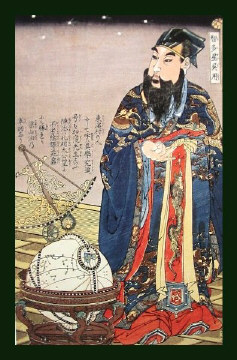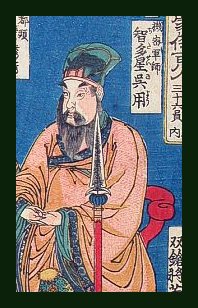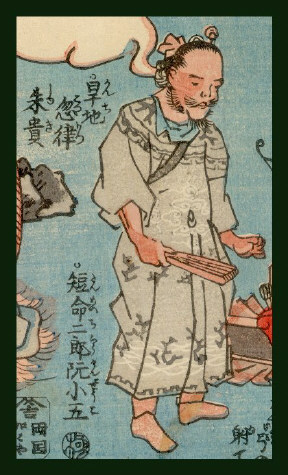
JAPANESE PRINTS
A MILLION QUESTIONS
TWO MILLION MYSTERIES
Ukiyo-e Prints浮世絵版画 |
|
Port Townsend, Washington |
|
UTAGAWA KUNIYOSHI |
|
歌川国芳 |
|
うたがわくによし |
|
One print from a series of comical representations of the 108 Heroes of the Suikoden |
|
Date: Early 1830s |
|
Publisher: Kagaya Kichiemon |
|
加賀屋吉右衛門 |
|
かがやきちえもん |
|
Size: 14 7/8" x 10" |
|
Illustrated: |
|
|
|
$540.00 |
|
This print is from a set of set and I believe it is the first one. |
|
|
|
KUNIYOSHI'S SOURCES FOR THIS SERIES |
|
|
|
Kuniyoshi's immediate source for these whimsical figures may be his own successful set of prints based on "108 Heroes of the Water Margin". Those in turn may have been inspired by Takizawa Bakin's edition of the Shinpen Suikogaden ('New Illustrated Edition of the Suikoden') which was illustrated by Hokusai.
Inge Klopmakers gives a wonderful summary of the first appearance in Japan and subsequent use and adaptation of the Chinese classic the Shuihu zhan.* |
|
|
|
*Of Brigands and Bravery: Kuniyoshi's Heroes of the Suikoden, by Inge Klopmakers, Hotei Publishing, Leiden, 1998. |
 |
狂 画
水 滸 傳 豪 傑 一 百 八
十 番 続 之 内 壹
|
||||
 Publisher: Kagaya Kichiemon |
|||||
|
CHITASEI GOYŌ 智多星呉用 ちたせいごよう CHINESE NAME: WU YONG |
||
|
|
||
|
Chitasei Goyō first appears in chapter 14 of the "Outlaws of the Water Margins", but is featured in the following chapter. As Wu Yong, his Chinese name, he is described as having "the appearance of a scholar.... His handsome and refined face was adorned with a long beard. This was Wu Yong the Wizard. He was also known as the Pendant. His Taoist appellation was Master Increasing Light." (1) |
||
|
1. Outlaws of the Marsh, by Shi Nai'an and Luo Guanzhong, published by The Foreign Languages Press, Beijing, 1993, Vol. I, p. 205. |
||
 |
 |
|
| Above is a partial image of Chitasei Goyō from a famous Suikoden set of prints by Kuniyoshi published between 1827-32. | Detail of a Kuniyoshi print from ca. 1845 showing another portrait of Chitasei Goyō. | |
|
|
||
|
THE MYSTERIOUS MAIDEN OF THE NINE HEAVENS 九天玄女 CHINESE NAME: JIUTIAN XUANNU |
 |
|
As of now I am unable to identify the smiling fellow whose hand is being held by the Taoist figure of the Mysterious Maiden of the Nine Heavens. Her name in Chinese is pronounced Jioutian Xuannu. Although I can't be sure this pair shown above may be a parody of Chapter 42 where Kohōgi Sōkō, Song Jiang is his Chinese name, while hiding from his pursuers has a dream in which he is taken to meet the Mystic Queen of the Ninth Heaven. |
|
|
|
My primary literary source for information regarding the 108 heroes is Outlaws of the Marsh, by Shi Nai'an and Luo Guanzhong published in three volumes by The Foreign Languages Press in Beijing in 1993. The episode mentioned above is in volume II. |
|
RŌRIHAKUCHŌ CHŌJUN 浪裡白跳張順 ろうりはくちょう CHINESE NAME: ZHANG SHUN |
 |
|
Inge Klopmakers notes that after Chōjun gave up his life of extortion and banditry he opened a fishmarket: "Before becoming the owner of a fish market [Chōjun and his brother]...cunningly rob people of their money." (Of Brigands and Bravery, p. 172). Considering his behavior as one of the heroes this is difficult to reconcile. I guess old habits die hard.
In the Outlaws of the Marsh (p. 585 - Chapter 37) Chōjun's brother sings his praises: "My mother bore two sons - me and my younger brother Zhang Shun. He's a remarkable boy, with skin as white as snow. Not only can he swim forty to fifty li on the surface of the water, he can stay below for seven days and seven nights." In fact he carries the sobriquet 'White Streak in the Waves'.
At this point the older brother, Heng, describes how he and Shun would team up to rob people. Heng would offer to ferry people across a river for a fee. Shun would pretend to be a passenger. Half-way across Heng would produce a large cutlass and demand an exorbitant surcharge. Shun would be the first one asked to pony up, but would refuse. Heng would then throw him overboard and Shun would disappear beneath the water. At this point the others would meet Heng's demand. Shun would swim underwater to the far shore and meet with his brother after the passengers had disembarked.
On page 601 of Chapter 38 Shun is described as "...our local catch-master." That would appear to explain the iconographic source for Kuniyoshi's image shown here. |
|
KANCHIKOTSURITSU SHUKI 旱地忽律朱貴 かんちこつりつしゅき CHINESE NAME: ZHU GUI |
 |
|
TANMEIJIRO GENSHOGO 短命二郎阮小五 たんめいじろうげんしょうご CHINESE NAME: RUAN XIAOWU |
|
|
|
|
|
|
|
KATSUENRA GENSHŌSHICHI 沽閻羅阮小七* CHINESE NAME: RUAN XIAOQI
*I have to admit that I am a bit stumped by the reading of the characters in this name. They do not conform to either the Chinese characters or the reading as translated into English. If I discover the reason I will emend this section. Until then I will stick with this. |
|
|
|
|
|
|
|
Direct purchase may be made through check or money order or by payment through PayPal. |



 HOME
HOME